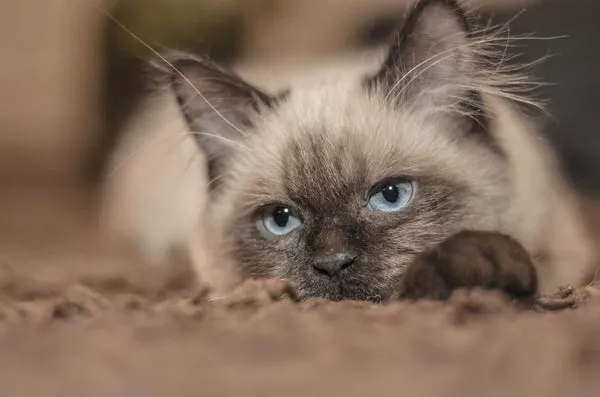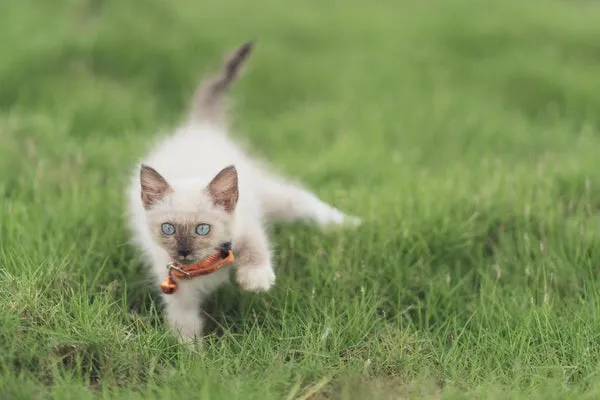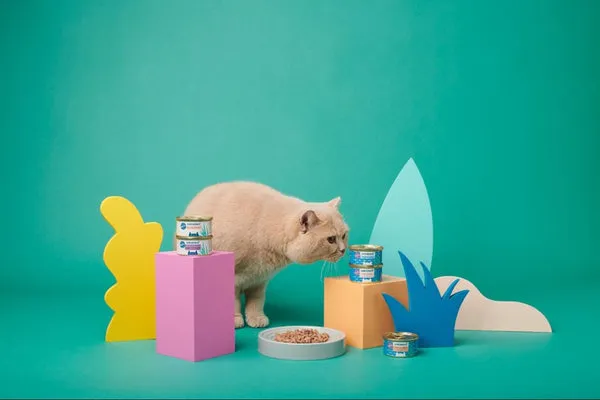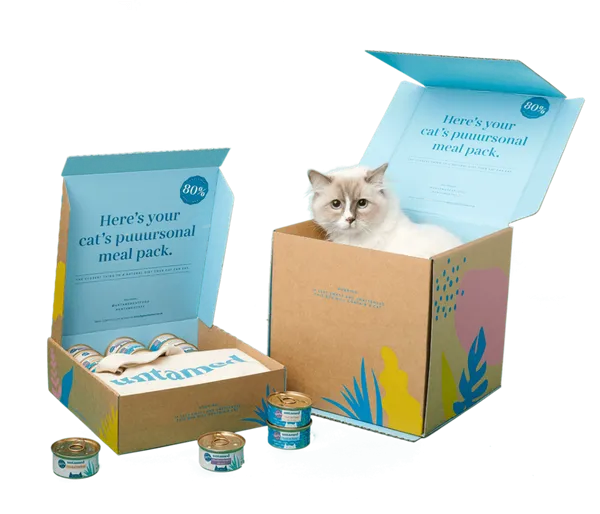Siamese cats are renowned for their captivating blue eyes, sleek bodies, and assertive personalities. They are masters of persuasion, often using their distinctive vocalizations and direct stares to get what they want, especially when it comes to food. While it’s tempting to indulge your beloved feline, unchecked treats and overfeeding can easily lead to a Fat Siamese Cat, a condition that poses significant health risks. Understanding the ideal weight for your Siamese and how to maintain it is crucial for their long-term health and happiness.
Cat obesity is an increasingly common problem, and though a chubby cat might seem endearing, extra weight can lead to a host of serious health issues, complicating your Siamese’s life. This guide will help you determine if your Siamese cat is fat, explore the causes and dangers of obesity, and provide practical strategies for weight management through proper diet and exercise. Ensure your Siamese can live a vibrant, healthy, and extended life by maintaining their ideal body condition.
What’s the Ideal Weight for a Siamese Cat?
A healthy adult Siamese cat typically weighs between 3 and 5 kilograms (approximately 6.6 to 11 pounds). However, this is a general guideline, as the ideal weight can vary based on several factors unique to each feline. These include gender, age, and genetic predispositions. Recognizing these individual differences is key to determining if your Siamese cat’s weight is truly healthy or if you have a fat Siamese cat on your hands.
Male vs. Female Siamese Cat—Weight Differences
Generally, male Siamese cats are larger and more muscular than females. A healthy male Siamese may weigh around 5.5 kg (12 pounds), while females typically range from 3.5 kg to 5 kg (7.7 to 11 pounds). These differences are natural, and it’s important to compare your cat’s weight to the appropriate range for its gender. Significant deviations above these averages could indicate an overweight or fat Siamese cat.
Siamese Cat Weight Chart by Age
Siamese kittens experience rapid growth during their first year, and it’s normal for them to gain considerable weight during this period. After one year, their weight should stabilize with minimal fluctuations. Some felines might add up to a kilogram of muscle by their second birthday. Monitoring your Siamese’s weight throughout their life stages is vital for early detection of potential weight issues.
The table below presents the average Siamese cat weight by age:
| Age | Male Siamese Cats | Female Siamese Cats |
|---|---|---|
| Newborns | 90–140 g | 90–140 g |
| 3 weeks | 180–280 g | 180–280 g |
| 1–2 months | 350–600 g | 350–600 g |
| 3 months | 0.9–1.8 kg | 0.9–1.3 kg |
| 6 months | 1.3–2.3 kg | 1.3–1.8 kg |
| 1 year | 3–4 kg | 2.7–4 kg |
| 2 years | 4.5–5.5 kg | 3.4–4.8 kg |
How Can Genetics Influence a Siamese Cat’s Weight?
Beyond age and gender, genetics play a substantial role in your Siamese cat’s overall size and build. Siamese cats born from smaller parents often have a more petite frame and will naturally weigh less. It’s crucial not to mistake a naturally smaller cat for an underweight one, or conversely, to assume a larger-framed cat can carry more excess weight. Always consider their genetic predisposition when assessing if your Siamese cat is fat or at a healthy weight.
How to Tell if You Have a Fat Siamese Cat
Determining whether your Siamese cat has gained excess weight can be challenging, as weight gain often occurs gradually and may not be noticed until it’s become a significant problem. A fat Siamese cat might not immediately appear obese, but a few simple physical checks can provide clear indicators. Regular assessment helps in early intervention, preventing more serious health complications.
Here are some reliable indicators that your Siamese cat is overweight:
- Rib and Spine Palpation: When you gently run your hands along your cat’s sides, you should be able to easily feel their ribs. If you have to press harder to feel the ribcage, your cat is likely overweight. If you cannot feel the ribs at all, your Siamese is obese and requires a weight loss plan. Similarly, you should be able to feel the spine without pressing too hard.
- Visible Fat Deposits: Look for noticeable fat deposits on each side at the base of the tail. These are often one of the first places cats store excess fat.
- Absence of a Waist: When you look at your cat from above, there should be a discernible waistline, a slight indentation behind their ribs. If your Siamese cat appears to be one continuous line from chest to tail, they are likely carrying too much weight.
- Abdominal Sag: While a slight primordial pouch (a saggy belly flap) is normal in some cats, an excessive pendulous abdomen that swings when they walk is a clear sign of a fat Siamese cat.
 A content Siamese cat lying on a bed, looking relaxed and comfortable.
A content Siamese cat lying on a bed, looking relaxed and comfortable.
What Causes Obesity in Siamese Cats?
Understanding the root causes of obesity is the first step toward helping your fat Siamese cat return to a healthy weight. Many factors can contribute to a Siamese cat becoming overweight, often a combination of lifestyle, dietary habits, and sometimes underlying health conditions. Identifying these contributors allows for a targeted and effective weight management strategy.
Many factors can contribute to obesity in Siamese cats:
- Overfeeding: This is the most common cause. Free-feeding, where food is always available, or feeding portions that are too large, can easily lead to excess calorie intake. Giving too many treats, even small ones, also adds up quickly.
- Lack of Exercise: Indoor cats, in particular, may not get enough physical activity to burn off the calories they consume. A sedentary lifestyle, common in many modern households, contributes significantly to a fat Siamese cat.
- Type of Food: Diets high in carbohydrates and low in animal protein can contribute to weight gain. Cats are obligate carnivores and thrive on high-protein, moderate-fat diets.
- Age: As cats age, their metabolism slows down, and they tend to become less active. Senior Siamese cats are more prone to weight gain if their diet and exercise aren’t adjusted accordingly.
- Neutering/Spaying: While crucial for health and population control, sterilization can lead to a decrease in metabolic rate and an increase in appetite, making a cat more susceptible to becoming a fat Siamese cat if food intake isn’t managed.
- Genetics: Although less common in Siamese cats known for their slender build, individual genetics can still predispose some felines to gain weight more easily.
- Medical Conditions: Certain health issues, such as hypothyroidism (though rare in cats) or hormonal imbalances, can lead to weight gain. Certain medications, like corticosteroids, can also contribute. It’s always wise to consult a vet to rule out underlying medical causes.
 A Siamese cat looking intently at something, showcasing its sleek profile.
A Siamese cat looking intently at something, showcasing its sleek profile.
Why is it Important for Your Siamese Cat to Maintain a Healthy Weight?
The consequences of having a fat Siamese cat extend far beyond aesthetics; they significantly impact your cat’s quality of life and longevity. Cats that maintain a healthy weight generally live longer, happier lives, and experience fewer health problems. An overweight cat typically has reduced energy, leading to less playfulness and activity. This can result in increased solitary behavior, lethargy, and even behavioral problems or depression.
Beyond psychological issues, all that extra weight places a tremendous strain on your cat’s body and can lead to a range of severe medical problems, including:
- Heart Disease: Overweight cats are at a higher risk of developing hypertrophic cardiomyopathy (HCM), a condition characterized by the gradual thickening and weakening of the heart muscle. This can lead to heart failure and other cardiovascular complications.
- Arthritis and Joint Injuries: The excess weight puts immense pressure on a cat’s joints, especially their hips and knees. This can exacerbate or accelerate the onset of arthritis, making every movement difficult, painful, and reducing mobility.
- Diabetes Mellitus: Obesity is a primary risk factor for feline diabetes. An obese cat’s body may become unable to produce enough insulin or effectively use the insulin it does produce to balance glucose levels, leading to high blood sugar.
- High Blood Pressure (Hypertension): This condition is frequently a consequence of other underlying illnesses, such as chronic kidney disease or thyroid gland issues, which can be worsened or triggered by obesity.
- Liver Disease (Hepatic Lipidosis): A severe and potentially fatal condition where the liver becomes overwhelmed with fat, often seen when overweight cats stop eating due to stress or illness.
- Urinary Tract Disease: Overweight cats may have difficulty grooming, leading to urinary tract infections, and are also at a higher risk for bladder stones.
- Reduced Life Expectancy: Studies consistently show that overweight cats have a shorter lifespan compared to their healthy-weight counterparts.
How Can You Help Your Fat Siamese Cat Achieve a Healthy Weight?
Helping your fat Siamese cat return to a healthy weight primarily revolves around two critical factors: increasing their physical activity and adapting their diet. A consistent and balanced approach to both will yield the best results for your feline friend. It requires patience and dedication, but the health benefits for your Siamese are immeasurable.
Encouraging Your Cat to Be Active
Cats are natural hunters, instinctively driven to climb, run, and chase prey. If your Siamese has become lazy or sedentary, it’s crucial to re-stimulate these inherent hunting instincts. Providing engaging toys and dedicated play time can make a significant difference. Start with short, regular play sessions and gradually increase their duration as your cat’s stamina improves.
You can encourage activity by providing toys your cat will love, such as:
- Interactive Toys: Balls, toys with feathers on a wand, and laser pointers (ensure to always end laser play with a tangible toy for a ‘catch’).
- Moving Toys: Remote-controlled mice or automated toys that mimic prey can keep your Siamese engaged for extended periods.
- Vertical Space: Cat trees, shelves, and window perches encourage climbing and jumping, adding vertical exercise to their routine.
Aim to play with your Siamese cat for at least 20 minutes a day, ideally in multiple shorter sessions. While it’s essential to find activities your Siamese enjoys, changing the game from time to time is also necessary, as Siamese cats can get bored quickly. Introducing food puzzles is another excellent way to make your kitty “work” for their food. These puzzles offer multiple benefits: physical exercise, cognitive stimulation, sensory engagement, immense fun, and slower eating, which aids digestion and satiety.
 A sleek Siamese cat intently focused, ready to pounce on a toy during playtime.
A sleek Siamese cat intently focused, ready to pounce on a toy during playtime.
Adapting the Diet for a Fat Siamese Cat
Feeding your cat the right portions of high-quality, protein-based food at regular intervals is the most straightforward and effective way to help them maintain or achieve a healthy weight. This means moving away from free-feeding and implementing controlled portion sizes. Consult your veterinarian for precise caloric needs, as these can vary based on your cat’s current weight, target weight, age, and activity level.
The following table provides general guidance on how many calories your cat should consume per day, depending on their weight and activity level:
| Cat Weight | Cats of Normal Weight | Cats Who Gain Weight Easily | Overweight Cats |
|---|---|---|---|
| 2.5 kg | 183 kcal | 131 kcal | 105 kcal |
| 3.5 kg | 245 kcal | 175 kcal | 140 kcal |
| 4.5 kg | 303 kcal | 216 kcal | 173 kcal |
| 5.5 kg | 362 kcal | 258 kcal | 207 kcal |
| 6.5 kg | 413 kcal | 295 kcal | 236 kcal |
Always use a measuring cup or scale to ensure accurate portions. Splitting daily meals into 2-3 smaller portions can also help manage hunger and metabolism.
How to Choose Appropriate Cat Food for Your Fat Siamese Cat
Choosing the right cat food is paramount when managing the weight of a fat Siamese cat. The composition of their diet directly impacts their ability to lose weight, maintain muscle mass, and feel satisfied. A high-quality diet focuses on ingredients that support a carnivore’s nutritional needs while limiting those that contribute to unhealthy weight gain.
A healthy cat diet should consist of:
- High-Quality Animal Protein: This should be the primary ingredient and make up a significant portion of the diet (at least 50%). Protein helps maintain muscle mass during weight loss and keeps cats feeling full. Look for named meat sources like chicken, turkey, beef, or fish.
- Moderate Fat Content: While fat is energy-dense, it’s essential for satiety, nutrient absorption, and coat health. The key is moderate, healthy fats, not excessive amounts.
- Low Carbohydrates: Cats are not designed to digest large amounts of carbohydrates. High-carb fillers can contribute to weight gain and disrupt blood sugar levels. Opt for grain-free or low-grain options.
- Essential Vitamins and Minerals: Ensure the food is nutritionally complete and balanced, containing all necessary vitamins, minerals, and taurine (an essential amino acid for cats).
- High Moisture Content: Wet food is often recommended for weight loss as it helps cats feel fuller with fewer calories and contributes to overall hydration.
You should steer clear of cat food products that contain the following ingredients:
- Excessive Fillers: Ingredients like corn, wheat, soy, and other grains in large quantities add calories without significant nutritional value for a carnivore.
- Artificial Colors, Flavors, and Preservatives: These offer no health benefits and can sometimes trigger sensitivities.
- Unspecified Meat By-Products: While some by-products can be nutritious, vague terms like “meat by-products” often indicate lower-quality ingredients.
- Added Sugars: Sugars contribute to empty calories and can lead to weight gain and dental issues.
- Certain Human Foods: Avoid feeding your cat human foods like onions, garlic, chocolate, grapes, and xylitol, as they are toxic to felines.
 A close-up of cat food being poured, symbolizing a healthy diet.
A close-up of cat food being poured, symbolizing a healthy diet.
Untamed Can Help Keep Your Fat Siamese Cat’s Weight in Check!
If you’re looking for high-quality cat food specifically formulated to help your feline friend maintain a healthy weight and address concerns about a fat Siamese cat, consider Untamed. We offer a range of delicious and nutritionally balanced recipes designed to support your cat’s health. Our meals are crafted with:
- Human-Grade Ingredients: Only the finest, human-grade meats and fish.
- High Protein Content: Packed with essential animal protein to fuel your Siamese and support lean muscle mass.
- Gently Steamed: Our cooking process preserves nutrients and natural flavors.
- Hypoallergenic: Made without common allergens, suitable for sensitive stomachs.
Many cat parents report witnessing fantastic benefits once they switched their Siamese to Untamed. Here’s what you and your Siamese companion can expect:
- First week: Improved digestion, leading to no mess in the litter tray and regular bowel movements.
- Second month: Reduced shedding, a noticeably nice and shiny coat, and better dental health.
- Fourth month: Improved muscle tone, fewer hairballs, excellent digestion, and strong bones.
- Long term: A stronger immune system, easy weight management, and overall improved health and vitality.
Where Do I Sign Up?
Joining the Untamed family is simple and straightforward. You can become a member of the Untamed clowder in three easy steps:
- Visit our Try Now page.
- Tell us about your Siamese cat’s preferences, life stage, any sensitivities, and food allergies.
- Choose a meal plan tailored to your cat’s needs and complete your order.
Your personalized starter box will arrive the next day, and once your kitty gives us a nod of approval, you can start receiving your Untamed deliveries every month. If you ever need to change the meal plan, your kitty decides they prefer gravy to jelly, or you want to cancel your subscription, you can easily do it from your account at any time.
 A curious Siamese cat inspecting a box of Untamed cat food, showcasing its intelligence.
A curious Siamese cat inspecting a box of Untamed cat food, showcasing its intelligence.
References
- Cats Protection. (n.d.). Heart murmurs and heart disease in cats. Retrieved from https://www.cats.org.uk/media/1040/vg11_heart_murmurs_and_heart_disease.pdf
